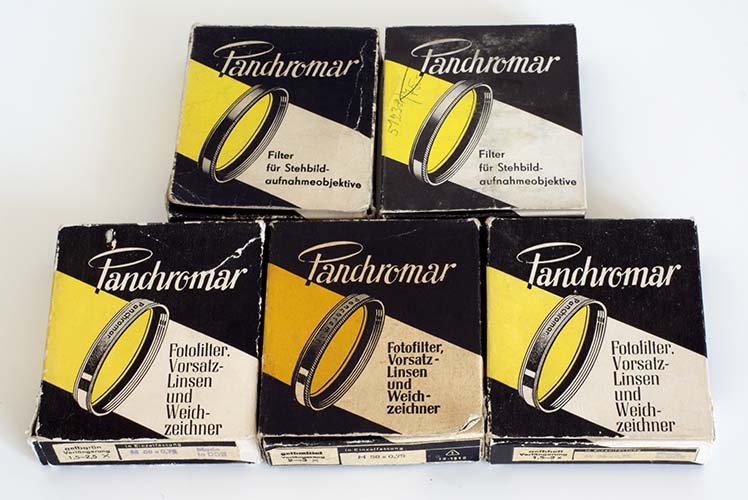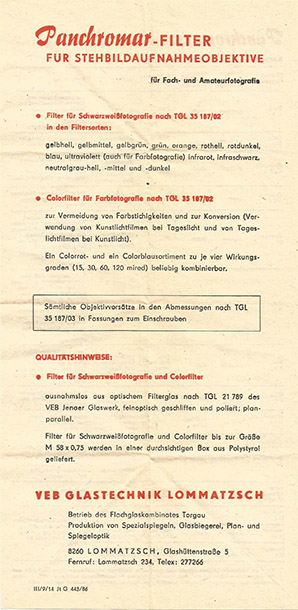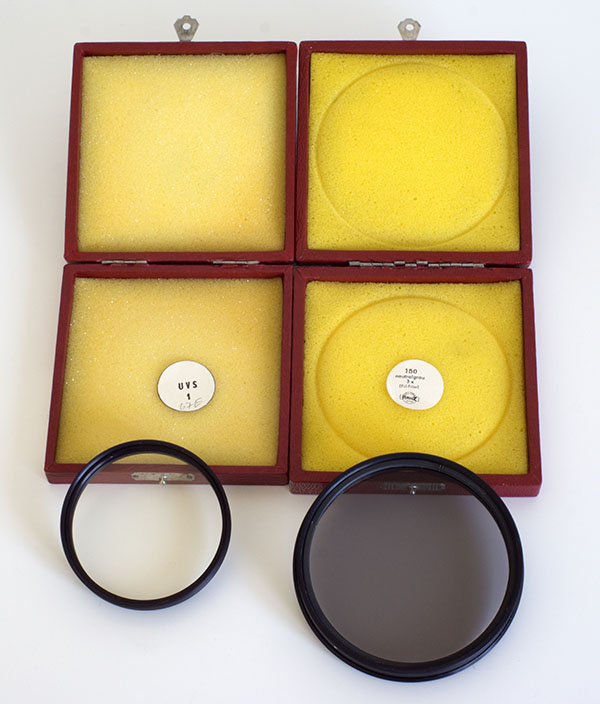by TRA
Filters for Pentacon Six lenses
On this page we look at a sample selection of filters from Carl Zeiss and some other East German manufacturers for Pentacon Six lenses. We start with a short introduction to colour and to the general use of filters in photography. Visitors familiar with this basic information can scroll straight down to the information on East German filters.
Basic colour
principles
The properties of colour filters have been known since at
least 1855, when James Clerk Maxwell submitted a paper to
the Royal Society in Edinburgh, in which he explained the
possibility of producing full-colour images by taking
three black-and-white photographs of a subject, each
through a different coloured filter, and combining the
images. In 1861 this was demonstrated by Thomas
Sutton, working with Maxwell, who took separate black and
white photographs through red, green and blue
filters. At the time of writing, more information on
this can be seen on the website of the Clerk Maxwell
foundation, here.
The negatives thus created were copied in order to produce
three separate positive black and white images on glass –
the original version of reversal slides for projection.
| The reason why Sutton and
Maxwell’s system works is because when a black and
white photograph is taken through a coloured filter,
the filter makes components of the image that have
the same colour lighter and
components of the image that have the complementary
colour darker. Thus,
when Sutton and Maxwell’s three monochrome slides
were simultaneously projected by three “magic
lanterns” (as slide projectors were called at the
time), each with the corresponding colour filter in
front of the projection lens, and the three images
were superimposed on a screen, a full colour image
was the result.
Complementary
Colours Using the three colours identified by Maxwell, the complementary colours are the following:
The principle of adding together information from Red, Green and Blue channels (often referred to as “RGB”) is still used for TVs, computer monitors and other devices. Colour printing in books, newspapers, product labels, computer printers, etc often uses the colours Yellow, Magenta and Cyan, often with the addition of black. The acronym for this is “YMC” or “YMCK”, where the “K” stands for “Black”, as the letter “B” is used for “Blue” in the acronym “RGB”. Red, Blue and Green are sometimes referred to as “additive” colours, while Yellow, Magenta and Cyan are called “subtractive” colours. There is a logic behind this terminology that is particularly relevant in printing colour photographs from an enlarger, in a darkroom, but to go into more detail here would be beyond the scope of this page. At the time of writing, there is a good description of this at http://www.colorsontheweb.com/Color-Theory/The-Color-Wheel |
|||||||||||||
Using colour filters in Black and White Photography
Knowledge of the above principles soon made the use of colour filters popular for black and white photography. By the 1930s, perhaps the most popular colour filter for landscape photography was Yellow, since this darkened the blue sky and so made the clouds stand out. A Deep Red filter would turn the cyan component of sky colours very dark, not far off black. However, a red filter used for a portrait of a lady would lighten red lips to a very pale colour and so was not popular for this.
Dr Heyde’s book “Pentaconsix Praxis” has an excellent chapter on filters (in German, naturally!). I reproduce here (translated into English) a table that is to be found on page 98 of the first edition of 1974 and of the second edition of 1975, and on page 80 of the third edition of 1980.
| Colour of
filter |
Colour of subject: | Blue |
Yellow |
Green |
Red |
| Colour reproduced: | |||||
| Yellow |
darker |
lighter |
unchanged |
lighter |
|
| Green |
somewhat darker |
lighter |
much lighter |
much darker |
|
| Orange |
much darker |
significantly lighter |
somewhat darker |
significantly lighter |
|
| Red |
very much darker |
much lighter |
significantly darker |
very much lighter |
|
Using filters in
Colour Photography
It is obviously possible to use colour filters in colour
photography, to achieve a particular “artistic”
effect. The result is an essentially monochrome
image in varying shades of the colour of the filter,
especially in the case of darker filters, such as dark
reds. However, most of the time obviously-coloured
filters are not used for colour photography, in which the
following types of filters are common:
- Ultra-violet (abbreviated “UV”). These filters are purported to reduce the effect of atmospheric haze, although most of the time they are principally used to protect the front element of the lens from damage.
- Polarizing filters. These filters reduce the light in one axis. They therefore need to be in rotating mounts and it is necessary to look through the filter while rotating it, in order to see how the effect changes at different angles in relation to the sun. The best way to do this is to use an SLR camera, which will view the subject through the lens, and therefore also through the filter. Polarizing filters substantially reduce reflections. Images in East German publications frequently show them being used to take photographs, from the street, of shop-window displays, without reflections of the street scene being visible in the glass of the window. However, polarizing filters can also reduce reflections from other sources, such as shiny leaves on plants, resulting in more saturated colours.
- Neutral density filters (often abbreviated to
“ND”). These grey filters reduce the light
entering the lens, enabling wider apertures or slower
shutter speeds to be used when desired. In recent
years they have become very popular in pictures that
include moving water (rivers, the sea, ...), to enable
such a slow speed to be used that the water becomes more
or less blurred. For such photographs, a tripod is
obviously essential. In the absence of an ND
filter, a polarizing filter can achieve largely the same
effect.
- Various colour-correction filters that have a very
pale density. They are designed to compensate for
an undesirable colour shift, as may be caused by some
slide films or close to sunrise or sunset, when the
ambient colour may be “warmer” (redder) than
normal. They are available in various intensities
and their use is essentially limited to photography on
reversal (slide) film, since with colour negative
material, any slight colour shift or colour cast will
(or should!) be eliminated during the printing
process. The digital equivalent is the “White
balance” setting on some digital cameras.
- In 1978 the French photographer Jean Coquin developed graduated filters. These filters were not round but square or rectangular. They typically had a dark colour (often grey, but not necessarily so) that faded to totally transparent at the other end of the filter. They were eventually marketed under the anglicised name “Cokin”. They can be ideal in landscape (and seascape) photography, to darken the sky and so bring out sky detail, without under-exposing the lower part of the image.
| Naturally, all these types of filters
can also be used in black and white photography
(although colour-correction filters are unlikely to
result in a visible difference in the picture). Other filters that can be used both in back & white and colour photography include:
|
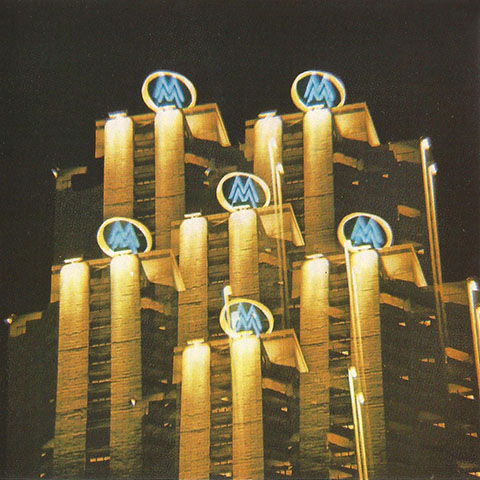 [multiimg.jpg]
|
Filter factors
If a filter is holding back some of the light in the
scene, obviously less light will reach the film.
With a particularly dense or dark filter, under-exposure
will result (the image will be too dark). It is easy
to compensate for this, and filters should be supplied
with a filter factor or exposure
factor. This will
typically be along the lines of “2×”, which means “double
the exposure indicated by the hand-held meter or other
exposure guide”. This is easily achieved by opening
up the lens by one stop (for instance, from f/11 to f/8)
or doubling the exposure time (for instance, by using
1/125 sec instead of 1/250 sec). Likewise, a filter
that had an exposure factor of 4× would require the lens
aperture to be opened by two stops (since each stop will
double the light intensity entering through the previous,
smaller aperture setting), or using a shutter speed “two
down” from the unfiltered speed (for instance, in the
above example, by using 1/60 sec instead of 1/250 sec).
Again, a table in Dr Heyde’s book “Pentaconsix Praxis”
may help to clarify the options. It, too, is to be
found on page 98 of the first and second editions and on
page 80 of the third edition.
| Filter factor |
Open the aperture by |
or increase the exposure time
by |
| 1.5× |
½ an aperture value (half a stop) |
– |
| 2 × |
1 aperture value (one stop) |
1 shutter speed value |
| 3 × |
1½ aperture values |
1 shutter speed value + ½ aperture
value |
| 4 × |
2 aperture values |
2 shutter speed values [or 1
aperture value and 1 shutter speed value] |
| 6 × |
2½ aperture values |
2 shutter speed values + ½ aperture
value |
| 8 × |
3 aperture values |
3 shutter speed values [or other
equivalent combination] |
However, photographers who use the TTL metering
prism on the Pentacon Six are spared all these
calculations, since the meter will measure accurately
the amount of light actually coming into the camera
via the lens and the filter.
|
Detailed
information on German Filters
I am grateful to Michael G from Germany for sending me a link to a detailed page on filters from Germany (East and West), the USA and other sources, written in German. However, visitors to this website who do not know German may obtain interesting information with the help of a translation program, and they may find the data charts fairly easy to understand with little or no knowledge of German, just translating a few key words, principally the words for the different colours. Here is the
link: https://photobutmore.de/vintagephoto/filter/filtervergleich/
That page is Copyright © by Horst Neuhaus. The author of the web page, Horst Neuhaus, points out that with analogue (film-based) photography, colour-correction filters were mostly used with “slide” or “reversal” film (“Umkehrfilm” in German), as the printing equipment in processing labs for negative film generally interpreted colour changes on the film as unintentional “casts” (German “Stiche”) that had to be edited out when printing – thus negating the effect of the filter! Neuhaus points out that with digital photography, the photographer can regain control of the use of such filters, always provided that white balance is set before the filter is attached to the lens. TRA, 28.4.23.
|
Filters for Pentacon
Six lenses
Naturally, filters from any manufacturer can be used with
any camera, provided that there is a convenient way of
fitting them to the lens. In the 1930s and 1940s,
many filters were in “push on” mounts. That
is to say, they gripped the front of the lens rather in
the way that most lens caps did until very recently.
However, already in the 1930s many photographic lenses had
a female thread at the front, so that filters could be screwed
in, and by the 1950s this became the most popular
way of attaching filters to a lens. In order to do
this, it was necessary to know the diameter
of the filter thread on the lens and the pitch,
i.e. the distance between each turn of the thread.
Carl Zeiss Jena succeeded in limiting the filter mounts
on lenses for the Pentacon Six to one of three sizes:
- 58mm with pitch 0.75. This was used for the 80mm Tessar and the 80mm Biometar standard lenses.
- 67mm with pitch 0.75. This was used for the 120mm Biometar lens.
- 86mm with pitch 1. This was used for the 50mm and 65mm Flektogon wideangle lenses and the 180mm and 300mm Sonnar telephoto lenses.
Standardising on filter sizes was popular with
photographers, since it meant that filters that they
bought could be used on several different lenses, thus
reducing financial outlay.
I am aware of four East German manufacturers of filters
for Pentacon Six lenses:
- Panchromar (see the changes to the manufacturer’s name
below)
- VEB Jenaer Glaswerk Schott & Genosse
- Hugo Arnz Optische Werkstätte, Jena
- Carl Zeiss Jena
We note that three of these manufacturers were in Jena,
the main centre for lens making in Germany and the
location of the original Carl Zeiss headquarters, while
the other one was in a suburb of Dresden, the centre of
excellence in camera design and manufacture. Here I
give some brief information on filters from these four
manufacturers. All the filters from these
manufacturers that I have seen were also front-threaded,
so that a lens shade (hood), or even another filter, could
be added. This also makes it possible to store
filters by screwing them together and adding a screw-on
back cap and a screw-in front cap, for protection.
| Panchromar filters were apparently
originally manufactured by the firm of Lehmann &
Balzer. They manufactured a wide range of
58mm filters suitable for the 80mm Tessar and
Biometar lenses, as well as 67mm filters suitable
for the 120mm Biometar and 86mm filters for the four
Zeiss lenses that required this size, which were
probably the only lenses being made at that time in
East Germany that took 86mm filters. The flyer illustrated to the right was found in inside the book “Pentacon Praxis” by Kurt Hartmann, which was published by VEB Fotokinoverlag Halle (3rd edition, 1961). The Pentacon camera referred to in the title of the book was the post-war 35mm Contax camera that was designed and manufactured in Dresden. Unlike the pre-war version, this was a single-lens reflex camera with a built-in pentaprism. This camera was initially referred to as the “Contax S” (although no cameras bore the “S” on the name plate). That camera is described here. Subsequent versions included the Contax D and E (see here). Subsequently, following numerous legal challenges by the new Contax firm in West Germany, the manufacturers coined a new name for their Pentaprism Contax, and renamed the camera “Pentacon” (see here). The text of this flyer states: “Panchromar
LEHMANN & BALZER – Lommatzsch / Dresden District Firm with Government shares” |
|
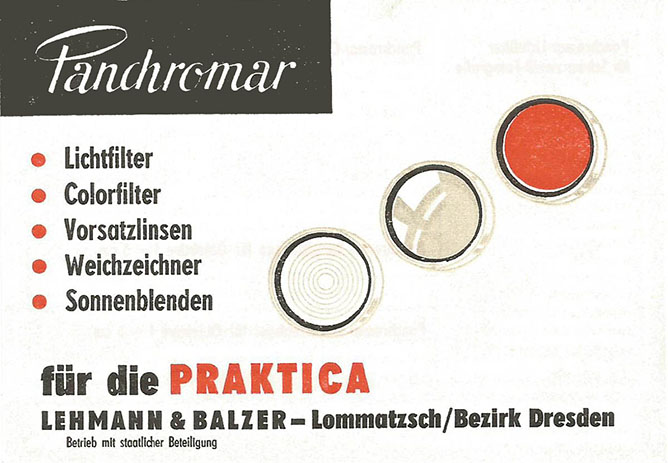 [planflyer_a.jpg]
|
|||||||||||
The reverse side of the same flyer
details the products available (translation from the
German by the author of this website):
Even though some filters are specified for 50mm lenses (for a 35mm camera), we must bear in mind that this flyer was probably produced in 1961. We know that Panchromar filters in other sizes were subsequently manufactured. |
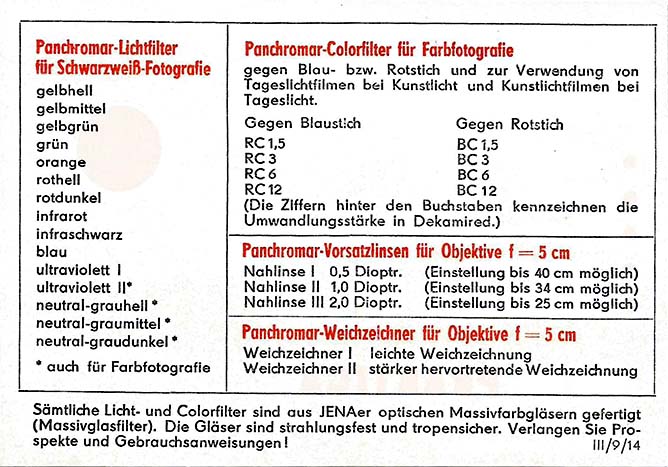 [panflyer_b.jpg] |
||||||||||||
| Some Panchromar filters still come
with the instruction sheet that was probably
originally enclosed with all their filters.
This is shown to the right. Those who wish to
study it in detail will get to a higher resolution
copy by clicking on the side of the sheet that
interests them. It would appear that by the time that this leaflet was produced (for inclusion with a filter for a Pentacon Six lens), one of the constant GDR government reorganisations and expropriations of private companies had resulted in the firm being renamed “VEB GLASTECHNIK LOMMATZSCH”. We remind readers that “VEB” stands for “Volks Eigener Betrieb” (usually written “Volkseigener Betrieb”), which means, literally, “People’s Own Works”, a euphemism for State-owned, since they were subject to the control of the East German government and the communist party (which was known in the GDR as the “SED”).
|
[panchroBA01s.jpg]
|
[panchroBA02s.jpg]
|
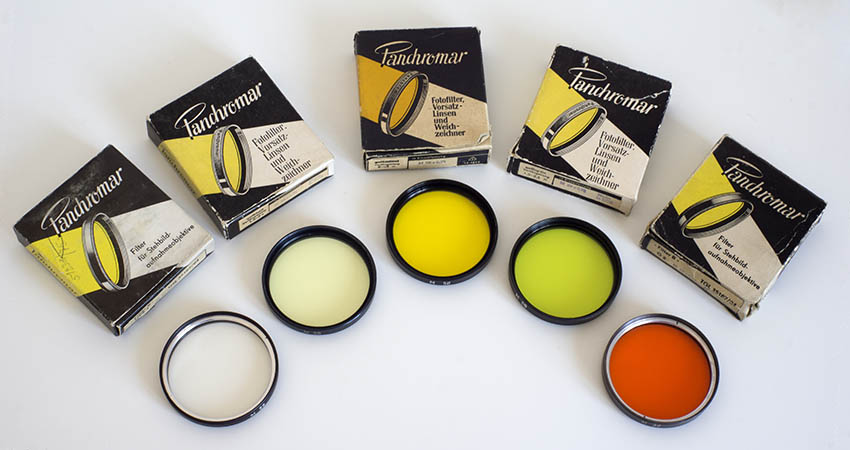 [58mmPan_fils.jpg] |
On the left, view of the filters that
came in these boxes. It seems strange that
with two of these filters, the front retaining ring
is bright chrome, instead of being anodized black to
prevent any possible risk of reflections.
There are reasons to believe that this particular
set of filters was manufactured between about 1960
and 1962, and shortages of all sorts of materials
were so severe under the communist system that old
components could not be thrown away but had to be
used. It seems that with with the UV filter on
the left and the orange filter on the right, we are
witnessing one of the transitions in which old stock
was used in the manufacture of newer products. The photograph on the right shows that the filter was supplied in a plastic hinged case, within its carboard box, with the instruction sheet that is reproduced above. |
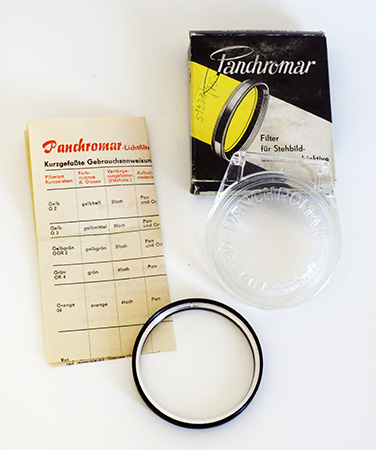 [58Pan_box_case.jpg]
|
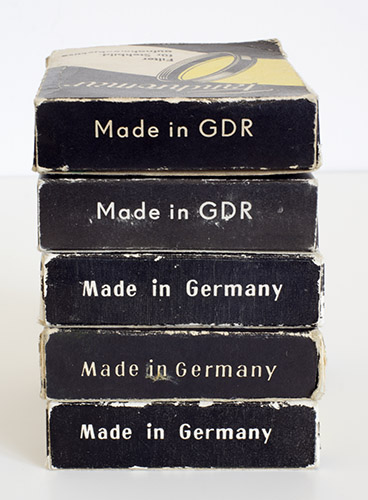 [58mmPan_bxs_02.jpg]
|
The text on the top flap of these
boxes helps with the dating of the manufacture of
these filters. Some of the boxes have “Made in
Germany” while others have “Made in GDR”. We
have seen (here)
that they key date for the commencement of the use
of “GDR” and “DDR” in East Germany, instead of
simply “Germany” was the building of the Berlin
Wall, which started on 13th August 1961.
Again, old stock, even if it was just cardboard
boxes, could not be thrown away, so some of these
boxes have the old designation, even though all of
these filters were probably manufactured at about
the same time. The plastic filter case illustrated below came in a post-1961 box labelled “Made in GDR”, yet it has the old designation “Germany” – another example of old stock being used instead of being discarded. 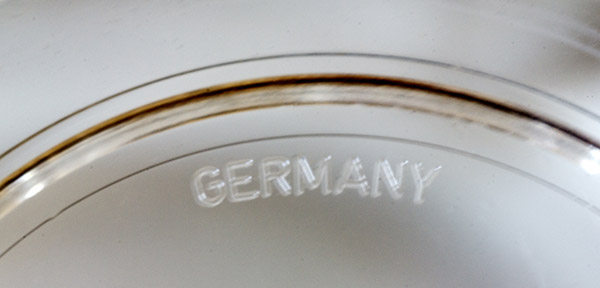 [58Pan_case.jpg] |
|
| We will conclude this section on
Panchromar filters with one last picture, this time,
of the box in which an 86mm Panchromar filter was
supplied. We can see that this is a UV filter,
and the box states “Verlängerung: praktisch keine” –
“Exposure extension: virtually none”. What surprises us is the nature of the box: the cover from a box for a smaller filter has been roughly cut out and pasted slightly off-centre on this blank cardboard box. We do not wish to be unfairly critical of the hard-working people who lived in Eastern Germany: they did their best with what they had, but frequently suffered from shortages of the most basic things. This box is illustrative of that sad state of affairs. |
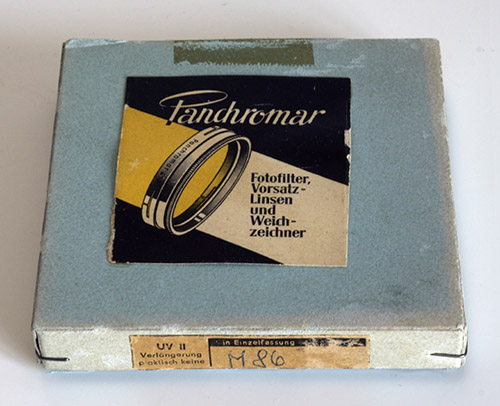 [86mmPan_box.jpg]
|
VEB Jenaer Glaswerk Schott & Genosse
As indicated in the section on lens shades (here), some 86mm filters for the wide-angle Flektogon lenses for the Pentacon Six were designed in a special mount, where the rear thread was (obviously) 86mm, but the front thread was 95mm. The purpose of making the front of the filter mount wider than the rear was to prevent the mount (or a lens hood attached to it) from darkening the corners of the picture (known as “vignetting”). As regards the filters themselves, this was no doubt successful with both of these wide-angle lenses, although the wide-angle lens shade, which was designed for the 65mm Flektogon, could introduce vignetting if used with the extreme wide-angle 50mm Flektogon lens. See more details on this subject here.
The manufacturer of these special filters was VEB Jenaer Glaswerk Schott und Genosse in Jena, which was the new, communist, name of the world-famous Schott glass company, which had been supplying glass for microscope and camera lenses to Carl Zeiss since the 19th century. According to Wikipedia (here), “in 1884, the glass chemist Otto Schott partnered with Ernst Abbe, Carl Zeiss and his son Roderich Zeiss, to found the Glastechnisches Laboratorium Schott & Genossen, which would later become Jenaer Glaswerke Schott & Genossen and then Schott AG.”
Naturally, for a lens shade to be mounted on these filters, it had to have a 95mm mount. So that the shade for the 65mm Flektogon could also be used on the lenses without one of these special filters, it was supplied with an 86mm-95mm adapter ring, which would first be removed from the shade when it was to be mounted onto one of these filters.
Filters with a mount diameter of 86mm are large and relatively expensive items and most photographers would not wish to have to go to the expense of buying separate filters in this size for each of their lenses. For this reason, the lens shades for the 180mm and 300mm Sonnars were also designed with a rear 95mm mount and supplied with an 86mm-95mm adapter ring, so that they could be used on these filters and also on these lenses without one of these filters, when required – even though, with these telephoto lenses, there was no risk of the filter mount or the lens shade causing vignetting.
| These filters were supplied in smart,
wooden boxes. The ones shown here were painted
grey, although other boxes have been seen that are
blue in colour (see here). Below we see a selection of these filters:  [schott05.jpg] |
|
 [schott10.jpg]
|
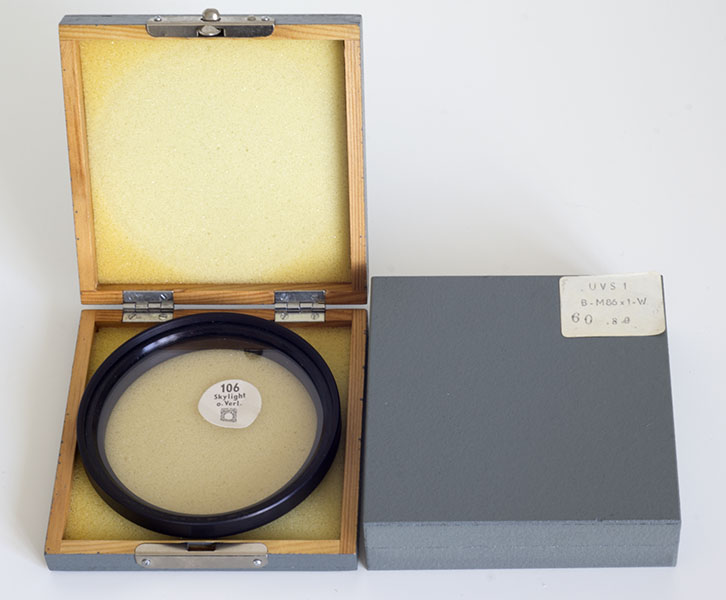 This filter is labelled “Skylight”, which is a common name for the R1.5 filter that reduces blueness in the image through slight warming. It is still popular and would probably be especially helpful for slides (reversal film) shot with Ektachrome film, which can tend towards blue. We note that the little label included in the box says “o. Verl.”, short for “ohne Verlängerung”, which means “without lengthening [of exposure]”. The box to its right has been placed upside down, to reveal the text of the label on its base. We can see that it is a UV filter, and the designation “M86 × 1-W” shows the filter diameter and pitch, while the “W” after this presumably stands for “Weitwinkel”, which means “Wide-angle” – an indication that the front thread is wider, with a diameter of 95mm, to avoid vignetting when used on a wide-angle lens (essentially the two medium format Flektogons). [schott06.jpg] |
|
 With these two
filters we see that a ticket and a label were
included. The rectangular ticket has the
manufacturer’s name and certain other
information. See close-ups of both sides
of the this ticket below. The round
label contains information specific to the
filter in question. The one on the left
has a reference number followed by “gelb,
mittel ca. 3×”, which means “mid yellow,
[exposure factor] approx 3×”. The one on
the right again gives the manufacturer’s
reference number, this time followed by “rot,
hell ca. 3–5×”, which means “light red,
[exposure factor approx 3–5×”. This does
remind us that when using such filters, it is
advisable to carry out tests at different
exposures in order to see the effect of using
the filter, or to bracket one’s exposures
(take a series of pictures on the metered
value and either side of it).
[schott07.jpg] |
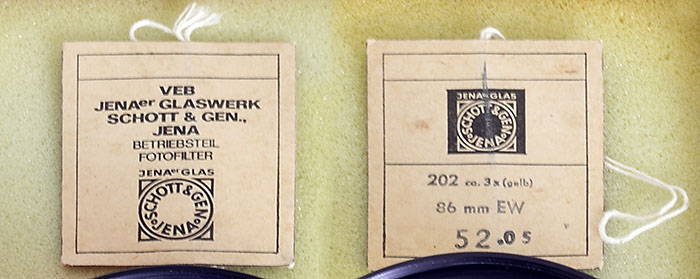 [schott_ticket_07.jpg]
|
|
The front of the ticket states “VEB
Jenaer Glaswerk Schott & Gen., Jena
Betriebsteil Fotofilter Jenaer Glas”,
followed by a company logo. The meaning of the
text is “State-owned Schott & Co. Jena, Jena
Glassworks. Business section: photo filters,
Jena Glass”. The back of the ticket gives the manufacturers reference number, the exposure factor and the colour, followed by “86 mm EW”, which gives us the rear thread diameter. It is presumed that “EW” refers to "wide-angle", perhaps “Extrem Weitwinkel”, which means “extreme wide-angle”. Schott was and is a world-leading manufacturer of glass and glass products. The Wikipedia article referred to above states that “During Germany's division, there were two independent companies: the VEB Jenaer Glaswerk at the historic site, which would later be integrated into the combine VEB Carl Zeiss Jena, and the glassworks in Mainz that traded under the name Jenaer Glaswerk Schott & Gen. After the close cooperation of the two glassworks in the first years following World War II had been cancelled by the GDR in 1953, a dispute arose over the use of company names and its logo, a square with a circle and the words Jena Glass with a superscript "er,". The two parties finally reached an agreement in 1981, which allowed the West German company to use the name "Schott" and the square with a circle, while the East German company was permitted to use the term "Jenaer Glass." After the fall of the inner German border in 1989, the company based in Mainz acquired the East German company in Jena.” |
We conclude this section on Schott filters with some pictures of one of their filters on a Carl Zeiss Jena lens for the Pentacon Six, and details of a lens hood and its adapter ring.
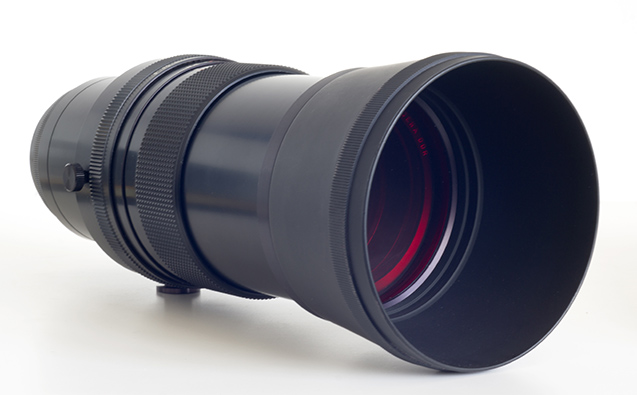 In the first three
images here, a red Schott 86mm filter with
95mm front thread is mounted on a Carl Zeiss
Jena 300mm f/4 Sonnar telephoto lens with the
Pentacon Six mount. Here we see the
lens’s standard lens hood mounted directly
onto the filter.
[schott01.jpg] |
|
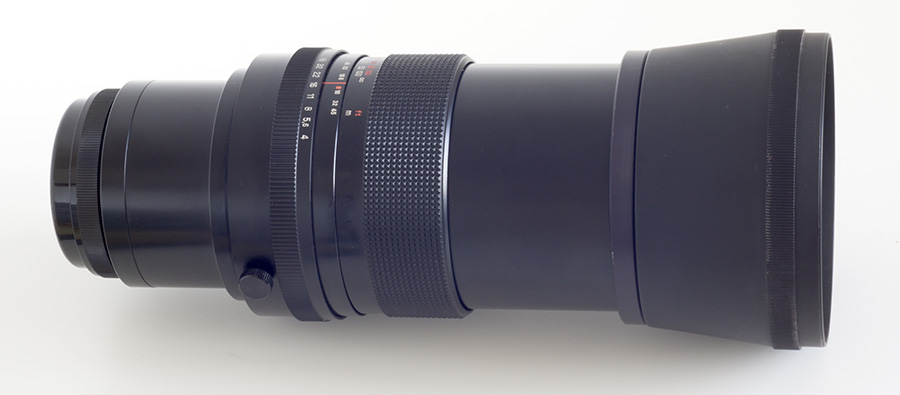 This side view
permits the shape of the filter mount to be
appreciated more easily, also showing how the
lens hood, which has a rear screw thread of
95mm, is screwed into it.
[schott02.jpg] |
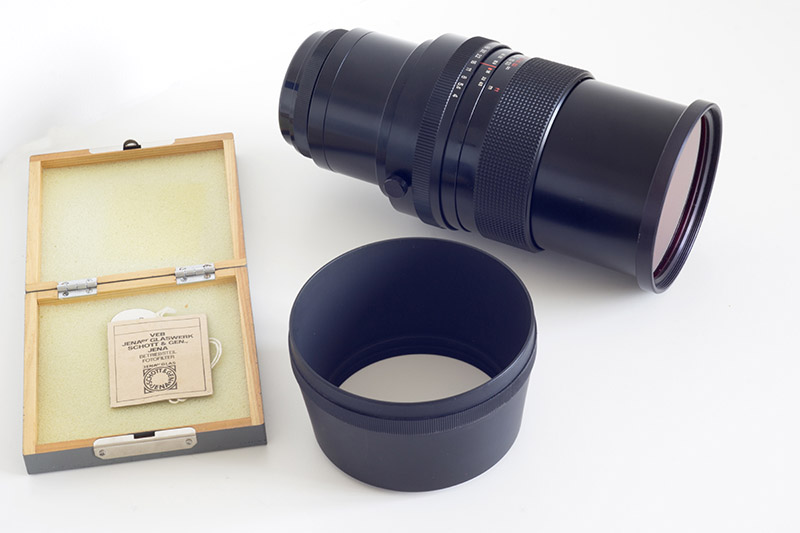 By removing the lens hood for
this picture, we are able to see the shape of the
filter mount more clearly.
[schott03.jpg]
|
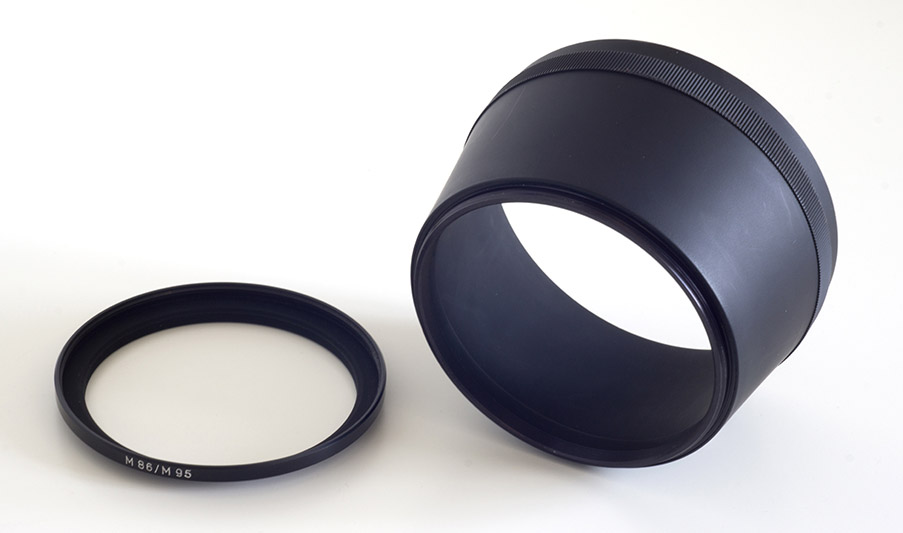 Here is the lens hood as
supplied with the 300mm Sonnar. The thread
on the shade itself is 95mm, and it is supplied
with the adapter ring that can be seen here
already mounted on the lens hood. The ring
states its front and rear thread dimensions.
[86mm95adpt.jpg] |
Hugo Arnz Optische Werkstätte, Jena
| This manufacturer of photographic
filters advertised in the book “Exakta
Kleinbild-Fotografie” by Werner Wurst, published by
VEB Fotokinoverlag Halle (6th edition, 1961). The image shows an “old-fashioned” clip-on (not screw-in) filter that also is not front-threaded to receive a lens hood or other filter. It shows a hinged plastic box for the filter, and an outer cardboard box. The text states: “A Sign for Quality All light filters for black & white and colour film, A-Z Colortester, Polarisationfilters, Ancilliary lenses and Soft-Focus filters” There is no indication of filter sizes, and Arnz may have concentrated principally on filters for lenses for 35mm cameras, which mostly had a smaller diameter. However, in his “Praktisix Buch” (Fotokinoverlag, 1964), Dr W Gerhard Heyde recommends the “Colortester” from Arnz, Jena (p. 196), and some Arnz filters in sizes suitable for Pentacon Six lenses are still occasionally to be found.
|
|
 |
Carl Zeiss Jena
| A polarizing filter in a rotating
mount was manufactured by Carl Zeiss Jena for the
standard Biometar lens (and also in a 49mm mount for
lenses used on the 35mm Praktica cameras). The
58mm version that is illustrated here was supplied
in a beautifully-stitched custom leather case. The straight white lines on the front edge of the filter were designed to make it easier for the photographer to align the filter correctly, even without needing to look through the camera viewfinder. Thus, the photographer could rotate the filter in front of his/her eye and note from the white lines the angle that gave the best effect, before screwing the filter onto the lens. The knurled edges make rotating the filter easier, once it is mounted on the lens. |
|
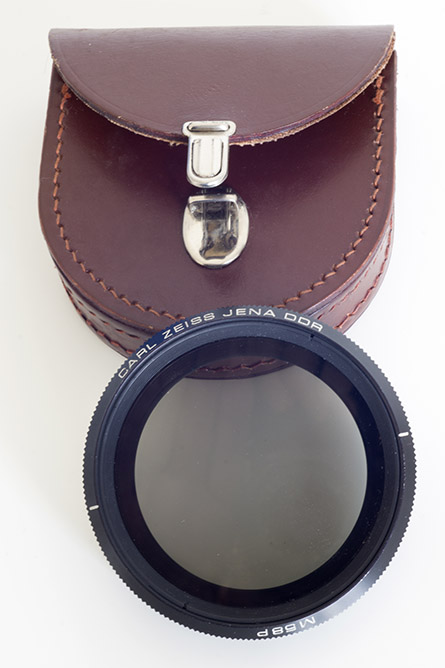 [czpolfiltr.jpg]
|
